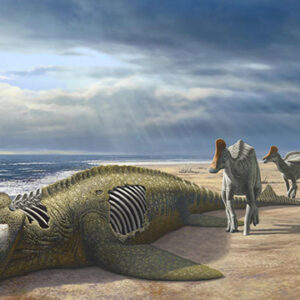
Just recently, archaeologists discovered evidence in Kenya that some of the earliest ancestors on the planet, dating back to three million years ago in fact, used tools.
The scientists explain that while these “early humans” were using some of the oldest stone implements to ever be found to cut up hippo meat and pound plant material on Lake Victoria’s shores.
Interestingly enough, the research group also shared that it would still be another two million years from the time when fire would be utilized by early humans, meaning these toolmakers would have eaten their food raw. Maybe, by pounding down this meat, it made it into some sort of “hippo tartare” to make it more palatable and easier to chew and swallow.
This amazing discovery, which is being referred to as one of the oldest examples of stone-age innovation known as an ‘Oldowan toolkit,’ is also considered the oldest evidence of hominins that ate very big animals.
According to the study findings which were published in Science journal, at the sites, the team also discovered bones from at least three different hippos. Two of the three skeletons were found to be incomplete, but some of the bones had signs of butchery. The archaeologists saw a deep puncture mark on one of the animal’s rib fragments, as well as a series of four short and parallel cuts on the shin bone of another one of the hippos.
There were also antelope bones that had evidence of hominins cutting away flesh using stone flakes, or others that were crushed by hammerstones to remove the marrow were seen as well.
In addition, the scientists also did an analysis of the wear patterns on 30 of the stone tools that were found at the site, and they showed that these stone tools were used to cut, scrape and pound both plants and animals.
Moreover, the international research team said that it was through the use of highly advanced dating techniques suggest that these artifacts are most likely to be around 2.9 million years old. However, they are at least between 2.58 to 3 million years in age at least.
As for lead author of the study, Professor Thomas Plummer from Queens College, City University of New York (CUNY), he said, “This is one of the oldest if not the oldest example of Oldowan technology. This shows the toolkit was more widely distributed at an earlier date than people realized, and that it was used to process a wide variety of plant and animal tissues.”
He added, “We don’t know for sure what the adaptive significance was, but the variety of uses suggests it was important to these hominins.”
Also, in the Nyayanga site, excavations done there also found a pair of enormous molars that belonged to a another close evolutionary relative of the human species’ known as Paranthropus.
Another study senior author, Dr. Rick Potts, explained that that teeth are the oldest fossilized dentures they’ve found of Paranthropus remains. This also raises a number of interesting questions about how they were found on a site full of stone tools, and which human ancestor actually made them.
As for Dr. Potts from National Museum of Natural History in the United States, he said “The assumption among researchers has long been that only the genus Homo, to which humans belong, was capable of making stone tools. But finding Paranthropus alongside these stone tools opens up a fascinating whodunnit.”
These tools were also found over 800 miles away from where the previously oldest known examples of Oldowan stone tools were found. These were the ones found at Ledi-Geraru in Ethiopia that were said to be 2.6 million years old, but they weren’t tied to any particular use or function.
As for the tools and animals found at the Nyayanga site, it was found that the wear patterns on them suggest they were used by early human ancestors on different food and materials, such as plants, meat and bone marrow too.
The research group went on to explain that the Oldowan toolkit has three types of stone tools, which are the hammer-stones, cores, and flakes.
Dr. Potts explained, “With these tools you can crush better than an elephant’s molar can and cut better than a lion’s canine can. Oldowan technology was like suddenly evolving a brand-new set of teeth outside your body, and it opened up a new variety of foods on the African savannah to our ancestors.”
It was because of some reports that talked about fossilized baboon-like monkeys that were found alongside human ancestors that brought the researchers to the Homa Peninsula in Kenya. During their many digs, which began in 2015, managed to uncover ‘330 artifacts, 1,776 animal bones and the two hominin molars identified as belonging to Paranthropus.’
According to Professor Plummer, the artifacts were “clearly part” of the stone-age technological breakthrough that is known as the ‘Oldowan toolkit.’ Plummer also shared that of the only other type of stone tools found before this, a set that was dated at 3.3 million years in age found on another Kenyan site, the Oldowan tools are still a “significant upgrade” in comparison and sophistication.
Professor Plummer also shared that over time, the Oldown toolkit eventually made its way throughout all of Africa, even as far as present-day China and Georgia. Moreover, it wasn’t replaced until around 1.7 million years ago as well.
As for Dr. Potts, he said, “East Africa wasn’t a stable cradle for our species’ ancestors.
“It was more of a boiling cauldron of environmental change, with downpours and droughts and a diverse, ever-changing menu of foods.”
“Oldowan stone tools could have cut and pounded through it all and helped early toolmakers adapt to new places and new opportunities, whether it’s a dead hippo or a starchy root,” he added.
What are your thoughts? Please comment below and share this news!
True Activist / Report a typo


